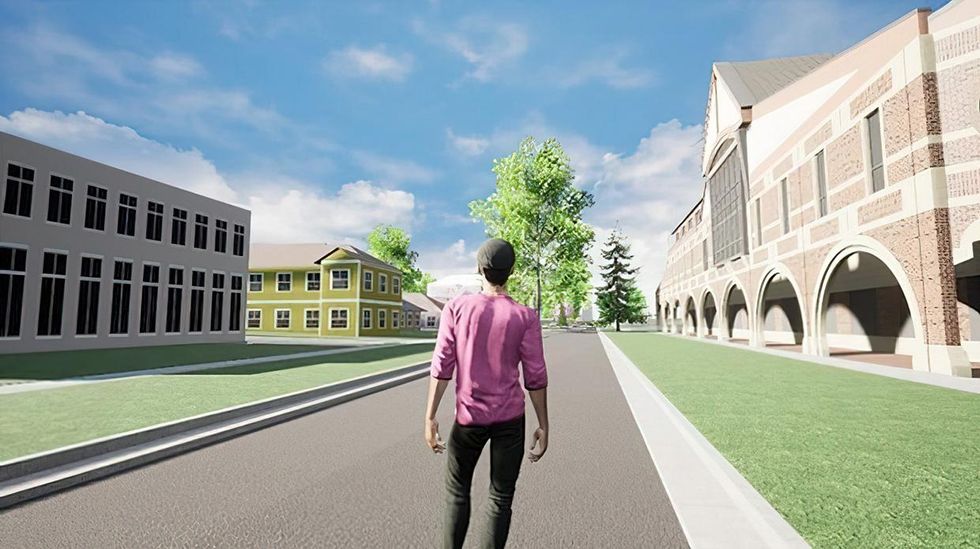Planning any large-scale project, whether it’s an apartment building, factory, or public infrastructure, is complex—and that complexity can make a project difficult to understand. ArcGIS Maps SDK for Unreal Engine aims to solve that problem by pairing the fidelity of Unreal with the accuracy of ArcGIS’s real-time geospatial data.
“Whether it’s a flat map that’s through a browser, or it’s a 3D experience in browser, or it’s a 3D experience on a mobile device, what we’re finding now is that 3D is not enough,” says Rex Hansen, the principal product manager of ArcGIS Maps’ software development kits (SDKs). “It needs to be immersive. It needs to be realistic.”
Construction from the eyes of an avatar
Esri, the company behind ArcGIS, released Maps SDK for Unreal Engine on 20 July 2022. Yet the project’s roots run deeper. The announcement of Microsoft’s HoloLens in October of 2016, along with the success of Niantic Labs’ AR game Pokémon GO, inspired Hansen to pursue SDKs that bring ArcGIS data to modern game engines.
“It really landed when we had our first public beta release in October of 2020,” says Hansen. “When that happened, we saw a lot of customers reach out across multiple industries. There’s a lot of excitement, a lot of ideas.”
That excitement is driven by Unreal Engine’s fidelity. Houseal Lavigne Associates, an urban planning and design firm, used Unreal Engine and ArcGIS Maps SDK to build an immersive, real-time 3D demonstration of proposed construction in Glen Ellyn, Ill. The demo let members of the village’s board of trustees view proposed changes through the eyes of a 3D avatar.

Esri is not limiting its efforts to Unreal Engine, however. The company also offers ArcGIS Maps SDK for Unity. The Unity version reached full release a month before the SDK for Unreal Engine, becoming available on 8 June 2022.
EIC Activities, an engineering and technical services business operating in Australia, uses ArcGIS Maps SDK for Unity to feed geospatial data into Virtual Builder, the company's “flight simulator for construction.” Engineers can virtualize project planning and look forward in time to gauge how future changes to a site, or its surrounding environment, will affect construction.
Hansen says each Maps SDK allows similar access to ArcGIS, but expects they’ll be used differently. Unity, the leading game engine by market share, has a lower barrier to entry and is popular with teams just getting started, while Unreal Engine has a reputation for powering projects that focus on detailed, immersive visuals.
Still, as Virtual Builder shows, Unity is certainly capable of large, immersive projects. The decision between engines may come down to an organization’s talent, as software developers working in architecture, engineering, and instruction are often less familiar with game engines.
Geospatial data is a big problem—and a big solution
The advantage of using a game engine to build an immersive environment is plain to see. But why do game engines need precise, geospatial data?
“The premium rendering experience, and all the other premium features the engine brings…we didn’t want to reinvent that,” says Hansen. “But the one thing game engines didn’t have, was they didn’t have a context or a canvas for displaying real-world data, and they didn’t have ready access to the sources of high-fidelity geospatial data.”
ArcGIS can provide data ranging from aerial photography to subsurface scans of the world’s oceans. There’s a good chance you’ve used a map powered by ArcGIS without knowing it: The platform’s data is used to track COVID-19 trends and wildfire activity, for example.
Houseal Lavigne used Unreal before ArcGIS Maps for Unreal Engine, but any edits to a project had to be made within Unreal Engine itself. Devin Lavigne, principal and cofounder of Houseal Lavigne Associates, says the downtown Glen Ellyn project streams its “entire 3D context” from ArcGIS. This includes contextual buildings and roads.
“If [a client's] city changes, with new buildings or roads, our client can use ArcGIS and publish new 3D layers, and the Unreal application will update,” says Lavigne.
Interest in Esri’s ArcGIS Maps SDK is currently driven by designers and engineers, but there’s a chance the SDK may come full circle to power augmented reality and simulation games that rely on geospatial data.
“There’s this first wave, which is really business-oriented customers,” says Hansen. “And the second wave is, once Esri gets to the point where we can host and deliver data for the higher demand that comes with games for entertainment, we’ll begin to see more interest in that space.”
The needs of game developers are more aggressive than those of business users who, by comparison, can accept higher latency and lower visual fidelity. It’s unclear if ArcGIS is ready to meet these demands—but, if ArcGIS Maps SDK proves successful, it could lead to detailed simulation games that blur the line between fiction and reality.
- Q&A: Why the Metaverse Needs to Be Open - IEEE Spectrum ›
- Will the Unreal Engine 5 Realize the Metaverse's Potential? - IEEE ... ›
- Video-Game Engineer Sushama Chakraverty Answered the Call of Duty - IEEE Spectrum ›
Matthew S. Smith is a freelance consumer technology journalist with 17 years of experience and the former Lead Reviews Editor at Digital Trends. An IEEE Spectrum Contributing Editor, he covers consumer tech with a focus on display innovations, artificial intelligence, and augmented reality. A vintage computing enthusiast, Matthew covers retro computers and computer games on his YouTube channel, Computer Gaming Yesterday.



